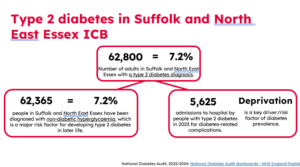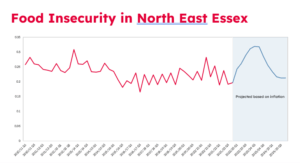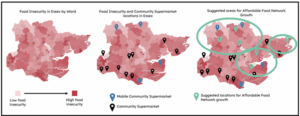We know, readers. You’ve all been waiting with bated breath for our next instalment of the Cost of Living Index blog series! Thankfully, there is no need for any more sleepless nights; we are here to deliver what the doctor (aka our managers) ordered – a Part 2!
In Part 1, we introduced our Cost of Living Index. If you have been living under a rock and haven’t read Part 1, we recommend you read it first: Assessing the Cost-of-Living Pressures on Our Residents – Part 1 -. To recap briefly, this index is built upon several domains of cost of living – such as food, energy, housing and more – and uses entirely open data to estimate the impact that these domains are having on local areas in Essex.
So, we now have an index and a dream. Well, actually, if a “dream” can be defined as “we have this cool model but we now need to do something impactful with it” then yes, we had a dream. We knew that rising Cost of Living had widespread impact on health outcomes, particularly for the most deprived households in the UK. The unfortunate reality is that the poorer you are, the greater the likelihood of not only dying sooner, but you’re also more likely to spend a greater proportion of your life in poor health. You’re more likely to be diagnosed with long-term physical and mental health conditions, but you’re also less able to access timely NHS care. As a result, you are more likely to need expensive emergency treatment.
We also knew that deprivation contributes to the risk of obesity and that obesity is a key risk factor for type 2 diabetes, which is often considered a preventable condition. With the prevalence of type 2 diabetes continuing to increase, particularly in more deprived areas of the country, we wanted to quantify the impact that the rising cost of living has had on health outcomes for people with diabetes over time. Essentially, we wanted to help connect the dots.
For this project, we tested our hypothesis on the population of North East Essex. With a significant proportion of the population already diagnosed with type 2 diabetes, and a further 62,365 diagnosed with a condition that is a major risk factor for developing type 2 diabetes in the future (hyperglycaemia), there has been significant pressure on primary healthcare settings in this area of Essex.

As the prevalence of type 2 diabetes within the UK is directly linked to the types of food people consume, we focused on predicting levels of food insecurity in North East Essex, by using the food domain within our Cost of Living Index. The result of increasing inflation rates mean that the cost of food is likely placing significant financial pressure on residents in areas of North East Essex.

We gathered information from the Suffolk and North East Essex ICB Linked Health and Care Data platform about diabetes-related medications, admissions to hospital, touch points and access to education programmes. Using fixed effects poisson regression modelling, we integrated this health data with food scores over time, at ward level, to estimate the impact that worsening food insecurity is having on health outcomes for people with type 2 diabetes in North East Essex.
In summary, our modelling found:
- For every increase in the food score, and therefore food insecurity, the likelihood of someone with type 2 diabetes attending a primary healthcare setting increases.
- For every increase in the food score, the likelihood of someone with type 2 diabetes attending other types of healthcare setting, such as community care, outpatient services, and A&E, also increases.
- When food insecurity increases, the number of type 2 diabetes-related medications being dispensed decreases.
- When food insecurity increases, the likelihood of being offered a diabetes education programme decreases, but the appetite for attending one, if offered, increases.
So – what’s the connection? Well, here’s what we think:
As food insecurity increases, the pressure on many healthcare settings increases as a result of type 2 diabetes-related attendances. At the same time, the number of prescriptions for medication used to treat type 2 diabetes and, the peoples access and take up of diabetes education decreases. This suggests that a patient’s ability to manage their diabetes independently, with medication and education, directly impacts on demand placed upon healthcare settings.
Being able to afford enough food and over and above this, being able to access healthy, nutritious food, is another way of enabling a person’s independence in managing many specific health needs . As such we looked at initiatives in Essex that could help support people with the cost of food.
Enter...the investment that Essex County Council has made into the Network of Community Supermarkets across the County. Currently Essex has 14 of them, more than one in each District, but the demand for these affordable food programmes has been significant, and there is appetite to expand the work and the impact of this growing movement. In return for as little as a £5 annual membership fee, residents can shop from a broad range of fresh, frozen, chilled and ambient products, enough to feed a family, at prices 35% lower than affordable supermarkets like Aldi and Lidl.
We wanted to see how Community Supermarkets might be impacting outcomes for people with type 2 diabetes. Our modelling found that for every kilometre a patient with type 2 diabetes lives away from their closest Community Supermarket, their likelihood of attending a primary care setting for their diabetes related issues, increases by 6%. That doesn’t sound like much, but if we think about the number of people in Essex with type 2 diabetes, and the number of attendances to primary care settings for their diabetes, then this impact adds up.
With the current success of the community supermarket programme allowing easier access to good quality food at affordable prices, there are plans to expand access to more communities across Essex.
Let’s rewind a little and take a look at a map of food insecurity across Essex wards:

As you can see, many of the wards with high food insecurity are also wards that typically are known for being more deprived. However, we can also see that some rural and coastal wards are also struggling with the cost of food.
Overlaying the locations of the current 14 Community Supermarkets shows that most of the fixed site supermarkets are located in North, South and West Essex. As a result of our Cost of Living analysis, our suggestions for areas where the growing Essex Affordable Food Network might want to focus are in North of Essex, in areas where food insecurity is high, including wards like Dovercourt Vines and Parkeston in Tendring.
The work undertaken to deliver a Community Supermarket in every District was very much a first step in working with communities to address the issues of food insecurity. A second phase of work, supported by investment from Public Health will seek to grow the capability and capacity of the Essex Affordable Food movement.
As a team we are continuing to work with colleagues who are supporting the expansion of the Community Supermarket model, and our findings have been used to understand the opportunities for future investment into the programme. We’re working with colleagues who are targeting financial wellbeing in Essex, and also external health colleagues in Essex ICBs to apply the index to other long-term health conditions.
What this project really shows is that an open data tool like the Cost of Living Index can be applied to a vast number of health and social care priorities. Open data can be incredibly powerful for connecting the dots, and what was a little side project has blossomed into an incredibly useful and accessible tool.
If you or your team think that the Cost of Living Index could help you connect the dots too, we’d love to hear from you. Keep your eyes peeled on data.essex.gov.uk for our Cost of Living Index dashboard; a completely open-use tool that will allow everyone to access our index.